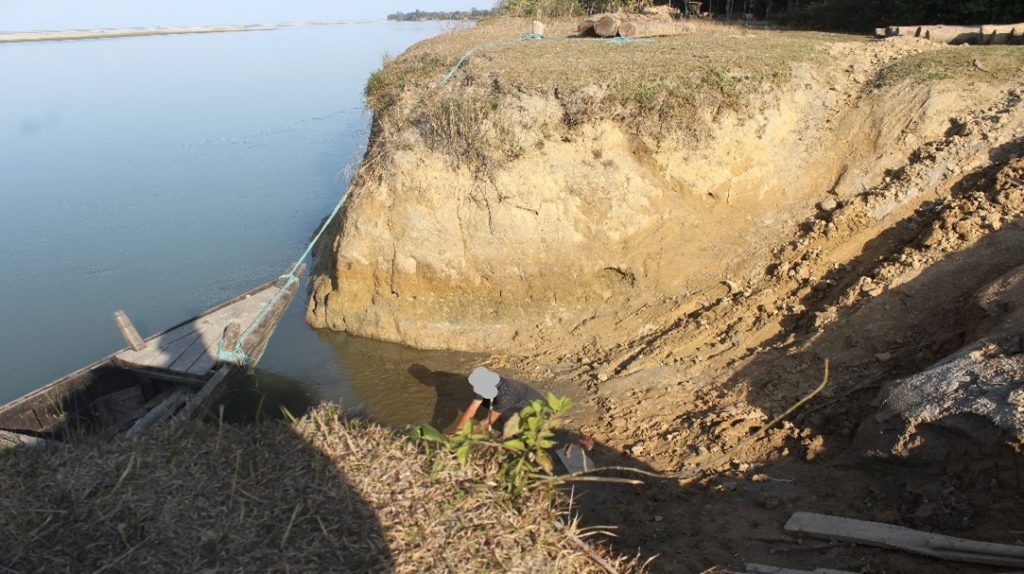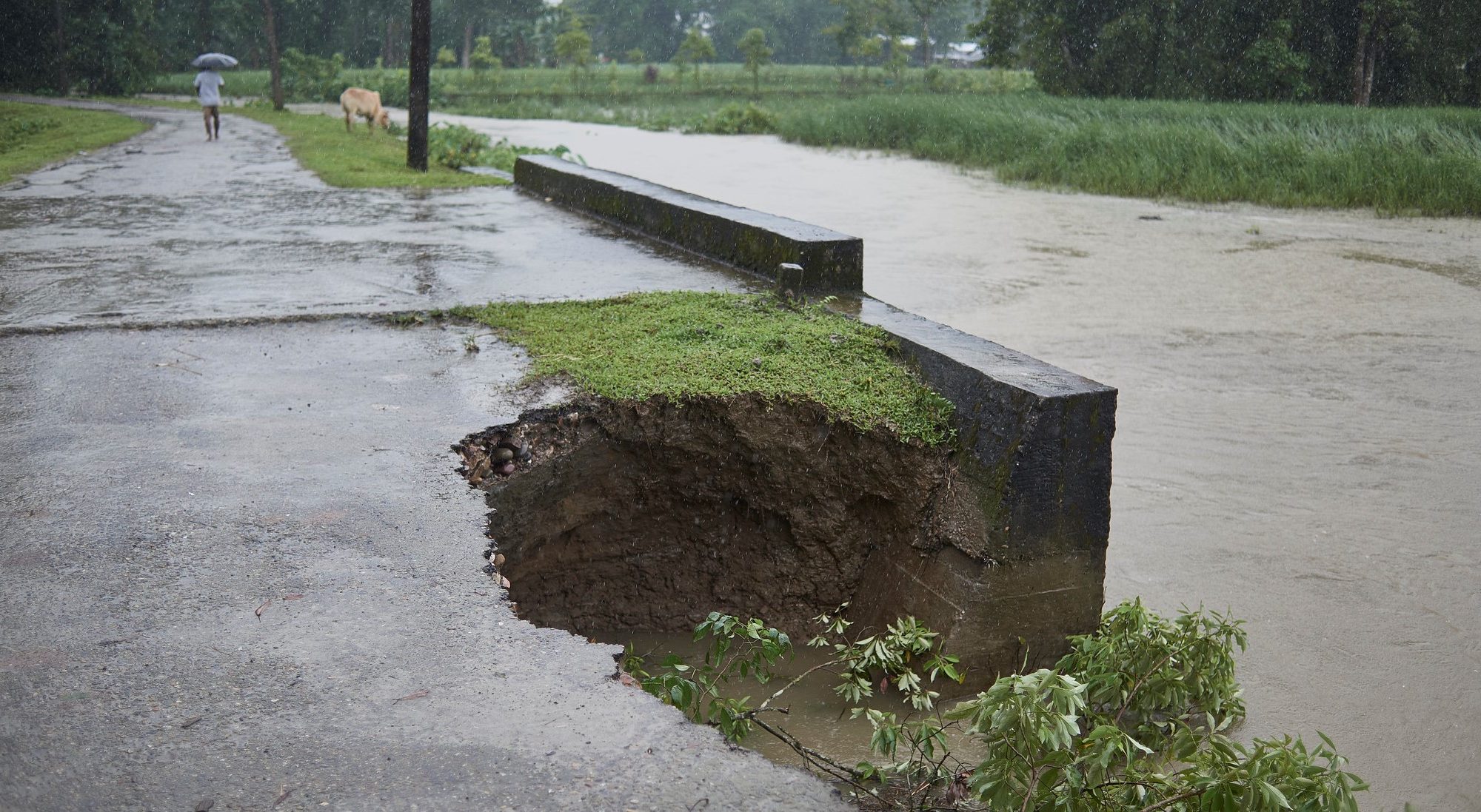By Mausumi Moran Chetia
Assam in the Northeast of India is tormented with disasters such as floods, riverbank erosion, and related displacement. Baan-Khohonia, as colloquially called, or floods-erosion are mutually related – floods can increase the rate of erosion of a river’s banks, and erosion in turn can lead to increased flooding.
As this is written, Assam is reeling under massive disasters, facing floods for the second time this year, erosion and landslides, aggravated by human interventions. At its peak, close to 5 million people were affected, while attracting the United Nation’s support. Official data state the death of 135 people; and report 176201 people who were living in relief camps until 28th June, excluding people living in unofficial, self-made relief camps.
Riverbank erosion: A silent disaster’s unaccounted faces
Riverbank erosion accompanies or follows floods in most cases. However, its scattered and slow nature makes it lesser focused in media compared to floods. This in turn can be argued to invite lesser scrutiny on state machineries to perform adequately.
For instance, during the emergency periods, erosion and floods-related displaced people can both live in official relief camps. When the floods recede (while erosion may continue), the flood-displaced people can return home, albeit facing heightened health and other risks. But for the displaced people whose houses and land got eroded, there is no home to return to.

Historically, ethnic groups, religious minorities and oppressed castes in Assam have been relegated to live along the banks of rivers. Many have therefore lost their houses, and agricultural land to erosion and recurring floods; resulting in chronic and permanent displacement. This leads to a deep lack of psychosocial well-being in the long run. This is furthered by the Indian state’s differential treatment of both disasters.
Policies of rehabilitation or designing displacement?
The Indian state’s approach is incongruent to floods and erosion. Whereas flood is listed as a disaster by the State Disaster Response Fund (SDRF 2015) which is used for relief distribution, erosion is not. Erosion, however, is recognised as a local disaster for Assam. But as observed, such dual policies at state and national levels make access to relief materials challenging for many erosion-affected people, while excluding many from long-term state rehabilitation.

Recently, dedicated policies have come to place to design resettlement of displaced people affected by coastal and river erosion in India, in the face of climate adversities. Discouragingly though, many limitations remain unaddressed in such an important policy (2020) of Assam: First, legal ownership of (eroded) land is an essential criterion for eligibility, land ownership itself being a contested issue in Assam and in Northeast India. Colonial cartographic exercises, especially for the tea industry, followed by multiple reorganisations of contemporary Northeast India, are agued to have led to land alienation and displacement of many ethnic groups to hills and near banks of rivers. Thus, they are the first and worst disaster-hit people. Consequentially, many of them are unable to show a legal relation to their eroded homes through documental evidence; while many are termed as encroachers living in government lands, despite contradictory historical evidences.
Second, the eligibility year for erosion-affected families is 2014-2015. That is, only people displaced from that period onwards are eligible under this policy. People displaced prior to this year appear to be without legal rights and accessibility to approach the state for rehabilitation. Third, there is no mention or provision of people’s temporary provision from the time of displacement until the time of rehabilitation.
Therefore, although targeted policies exist, in parallel there exists a mammoth of roadblocks for erosion-affected people to actually obtain the rights.
Ad-hoc inclusion within the humanitarian-aid world
Similarly, erosion-affected communities often tend to be excluded from long-term humanitarian aid actions such as housing reconstruction. This is due to unavailability of land unless provided by the state or the displaced persons or any other entity. The exception to this is within the Disaster Risk Reduction (DRR) framework; demonstrated by non-governmental organisations like the North-East Affected Area Development Society (NEADS), and others.
Morigaon is one of the worst erosion-affected and flood-prone districts. A local women’s rights organisation, Morigaon Mahila Mehfil (MMM), works with erosion-displaced people. Wahida Rehman who heads the organsation observes that such communities are from heterogenous ethnic, religious, and linguistic backgrounds. Mostly living in self-set up tarpaulin camps on embankments; they constitute of women, children, and elderly, as the men migrate to other towns as daily wage workers. Such families have been displaced for at least 5-10 years.

Displaced as data in times of climate crisis:
Assam’s case of erosion and related displacement strongly resembles what’s happening in Bangladesh – a globally recognised issue, whereas the former is rarely discussed even within India. India’s first-ever climate change assessment report (2020) does not mention riverbank erosion, although it discusses risks related-to coastal erosion. However, it does observe that the increase in floods in the Ganga-Brahmaputra basin are also compounded by subsidence of land (such as erosion or landslide). Based on a 2021 study, Assam is argued to need nearly 943 years to protect itself from floods with its current pace of flood protection and climate adaptation measures. Such observations in turn may indicate towards growing risks of disaster-displacement in the region.
Despite this, and 24 years after the UN Guiding Principles on Internal Displacement (1998), there is no central database of permanently erosion-displaced people of Assam. What is available is sporadic at best and no systematic data at worst. People living through the current disasters believe that this flood is the worst in decades.
Locally and globally, it is agreed that climate change may have a role in the current floods and erosion-displacements. Assam received an excess of 109% rainfall for June 2022. Between March to May 2022, 62% above normal rainfall occurred, which is the highest in 10 years. Equally critical though is the historical-structural context of Assam’s erosions and the Indian state’s handling of floods. Colonial land mapping and distribution practices, as mentioned earlier, an overly physical infrastructural framework with alleged mishandling of funds, an exclusively techno-managerial approach and state apathy, can be argued as some of the cumulative contributors towards disaster risk creation and related displacement in Assam. This absence of a people-first approach in reaching solutions and erasure of data on riverbank erosion-related displacement can lead to what is called death of a legal person.
Assam’s case of erosion-related displacement, therefore, is evidence of human lives falling into the cracks of power tussles – invisiblised human lives that are getting displaced as data too.
Note: This article gives the views of the author, not the position of the EADI Debating Development Blog or the European Association of Development Research and Training Institutes.
Mausumi Chetia is a PhD Researcher with the International Institute of Social Studies at Erasmus University Rotterdam. Her research is on ideas of home and human security of people facing permanent disaster-displacement in Assam, India; and is part of the Erasmus Initiative called Vital Cities and Citizens. Prior to joining academics, Mausumi was engaged as a practitioner in humanitarian aid in India.
Title Image: Climate Centre under a creative commons licence on Flickr

